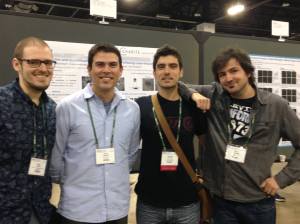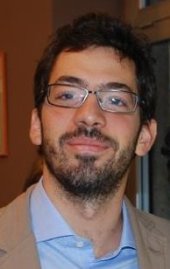Here Sergio. Coming from Spain, I have ended contributing to REVAMMAD project holding the ESR3.2 position.
As a biologist, I have always been concerned about biomedical current needs and how projects such as REVAMMAD are strictly necessary to address problems at the clinic that makes people’s life difference. When I knew about REVAMMAD’s goals, I was hardly encouraged by my own aims to become part of the team and contribute to generate solutions to problems in ophthalmology.
We develop one of the partnerships from Berlin, Germany, at the Charité Hospital. Under the supervision of Prof. Joussen (head of the ophthalmology clinic) and Prof. Strauß (head of the experimental ophthalmology research department) I am developing my PhD thesis and current research flow work.
My role inside REVAMMAD lies closer to what is called basic research more than something with straight transference into the clinic. However, the motto we have is to generate something that at the end will have a real application and use on patients. We all partners pursue a big common goal inside the project, but as long as my expertise remains close to genetics (MSc in Genetics and Cell Biology), we approach our retinal studies with animal models that reproduce retinopathy diseases.
To approach retinal vascular diseases it is necessary to adopt different strategies to understand the mechanisms of the pathology and transfer that knowledge into practical clinical tools. Vasculature in the retina changes under pathological conditions. However, vessels are not alone and we have to understand the disease as a complex puzzle where every piece has its role. Some other cell types besides the ones that compound vessels might be involved in terms of disease, as it is the case of neurons and microglia. Microglia belongs to the immune system at the retina, but its role in disease it is not clearly understood. Current models of imaging and algorithm analysis are pursuing early diagnosis regarding the dynamics and structure of the vasculature. In our basic medical research, we aim to switch the disease correlation into a new concept that involves vessels inside the neurovascular unit, where microglia might play a role, turning the current analysis model into one more complex and defined status.

 Supervisor. Chloe Wheeler choose Department of Biomedical Sciences of Copenhagen University and expressed a wish to spend a few days among staff and get an idea about the work in Medicine Institute.
Supervisor. Chloe Wheeler choose Department of Biomedical Sciences of Copenhagen University and expressed a wish to spend a few days among staff and get an idea about the work in Medicine Institute.











 solve engineering problems.
solve engineering problems.


